Can-Am
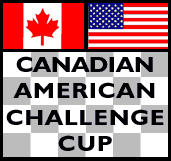 The logo of the Can-Am Challenge Cup | |
| Category | Sports car racing |
|---|---|
| Country | United States, Canada |
| Folded | 1987 |
The Canadian-American Challenge Cup, or Can-Am, was an
The Can-Am rules were deliberately simple and placed few limits on the entries. This led to a wide variety of unique car body designs and powerful engine installations. Notable among these were
History

Can-Am started out as a race series for group 7 sports racers with two races in Canada (Can) and four races in the United States of America (Am). The series was initially sponsored by
The group 7 category was essentially a
SCCA sports car racing was becoming more popular with European constructors and drivers, and the United States Road Racing Championship for large-capacity sports racers eventually gave rise to the group 7 Can-Am series. There was good prize and appearance money and plenty of trade backing; the series was lucrative for its competitors but resulted, by its end, in truly outrageous cars with well over 1,000 horsepower (750 kW) (the Porsche team claimed 1,500 hp (1,100 kW) for its 917/30 in qualifying trim[1]), wings, active downforce generation, very light weight and unheard of speeds. Similar group 7 cars ran in the European Interserie series from 1970 on, but this was much lower-key than the Can-Am.
On-track, the series was initially dominated by
The
Can-Am remains a well-remembered form of racing due to its popularity in the 1960s and early 1970s, the limited number of regulations allowing extremely fast and innovative cars and the lineup of talented drivers. Can-Am cars remain popular in historic racing today.
Notable drivers
Notable drivers in the original Can-Am series included virtually every acclaimed driver of the late 1960s and early 1970s. Jim Hall, Mark Donohue, Mario Andretti, Parnelli Jones, George Follmer, Dan Gurney, Phil Hill, Denny Hulme, Jacky Ickx, Bruce McLaren, Jackie Oliver, Peter Revson, John Surtees, and Charlie Kemp all drove Can-Am cars competitively and were successful, winning races and championship titles. Al Holbert, Alan Jones, Keke Rosberg, Patrick Tambay, and Al Unser Jr. are among the drivers who launched their careers in the revived Can-Am series.
Pioneering technology
Can-Am was the birthplace and proving ground for what, at the time, was cutting-edge technology. Can-Am cars were among the first race cars to use sport wings, effective turbocharging, ground-effect aerodynamics, and aerospace materials like titanium. This led to the eventual downfall of the original series when costs got prohibitive. However during its height, Can-Am cars were at the forefront of racing technology and were frequently as fast as or even faster around laps of certain circuits than the contemporary Formula One cars. Noted constructors in the Can-Am series include McLaren, Chaparral, Lola, BRM, Shadow and Porsche.
Manufacturers
McLaren
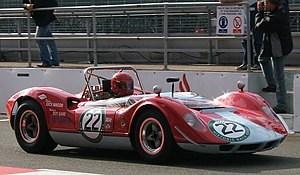
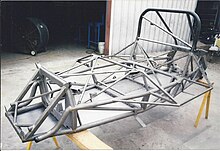
McLaren cars were specially designed race cars. The Can-Am cars were developments of the sports cars which were introduced in 1964 for the North American sports car races. The team works car for 1964 was the M1. For 1965 the M1A prototype was the team car and bases for the Elva customer M1A cars. In late 1965 the M1b(mk2) was the factory car in 1966 with Bruce McLaren and Chris Amon as drivers. In 1967, specifically for the Can-Am series, the McLaren team introduced a new model, the
Porsche

The
For 1972 the 917/10K with a turbocharged 900 horsepower five-litre flat-12 was introduced. Prepared by Roger Penske and driven by Mark Donohue and George Follmer these cars won six of the nine races. In 1972 Porsche introduced an even more powerful car, the 917/30KL. Nicknamed the "Turbopanzer" this car was seen as a monster. With 1,100 or 1,580 horsepower (820/1161 kW in race or qualifying trim)[citation needed] available from its 5.4 litre flat-12 and weighing 1,800 lb (816 kg) with better downforce this car won six of eight races in the 1973 championship.[2] Porsche's dominance was such that engine rules were changed to try to reduce the lack of competition for one marque by enforcing a fuel-consumption rule for 1974. This kind of alteration of rules to promote equality is not unknown in other forms of American motorsport. The category that the car had been created for and competed in was discontinued and in 1975 Donohue drove this car to a closed-course world-speed record of 221 mph (average)(356 km/h) at the Talladega Superspeedway (then called the "Alabama International Motor Speedway"). It was capable of 240 mph (386 km/h) on the straights.[3]
Chaparral
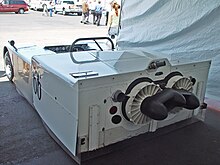
Lola
The
Others

While McLaren and Porsche dominated the series for most of its existence, other vehicles also appeared. Well-established European manufacturers like Lotus, CRD, in the form of their Merlyn Mk8 Chevrolet, Ferrari and BRM, appeared at various times with limited success, while March tried to get a share of the lucrative market in 1970–71, but could not establish themselves. Ford also flitted across the scene with a number of unsuccessful cars based on the GT40 and its successors. American specialist marques like McKee, Genie and Caldwell competed, alongside exotica like the astonishing four-engined Macs-It special.
British-born mechanic and engineer Peter Bryant designed the Ti22 (occasionally known as the Autocoast after one of the team's major backers) as an American-built challenger to the British McLarens and Lolas. The car made extensive use of
Decline and revivals
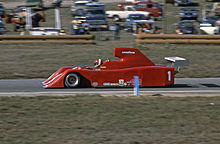
The last year for the original Can-Am championship was 1974. Spiraling costs, a recession in North America following the oil crisis, and dwindling support and interest led to the series being canceled and the last scheduled race of the 1974 season not being run.[4]
The Can-Am name still held enough drawing power to lead SCCA to introduce a revised Can-Am series in 1977 based on a closed-wheel version of the rules of the recently canceled Formula A/5000 series. This grew steadily in status, particularly during the USAC/CART wars of the late 70s and early 80s, and attracted some top road-racing teams and drivers and a range of vehicles including specials based on rebodied single seaters (particularly Lola F5000s) and also bespoke cars from constructors like March as well as smaller manufacturers. To broaden the appeal of the series a 2L class was introduced for the last several years—cars often being derived from F2/Formula Atlantic. The series peaked in the early 80s but as the CART
In 1991, after 18 months of development, a Shelby Can-Am series was created using a production line of Sports bodied cars designed by Carroll Shelby powered by a 3.3 litre Dodge V6. The series ran for five years before it was dropped by the SCCA. A large number of cars were relocated to South Africa and ran from 2000 onwards.
The name was once again revived in 1998, when the
Circuits
Champions
Under 2 Litre class champions
| Year | Driver | Team | Car |
|---|---|---|---|
| 1979 | Lola T290-Ford | ||
| 1980 | Hart
| ||
| 1981 | TrueSports
|
Hart
| |
| 1982 | Marquey CA82- Hart
| ||
| 1983 | Scandia B3- Hart
| ||
| 1984 | March 832-BMW | ||
| 1985 | March 832-BMW |
References
- ^ Nevison, Robert (director) (2008). CAN-AM: The Speed Odyssey (documentary).
- ^ http://www.wspr-racing.com/wspr/results/canam/canam1973.html 1973 Can Am results
- Daytona Beach Morning Journal. AP. August 10, 1975. p. 1B. Retrieved April 24, 2015.
- ISBN 0-7603-0017-8.
Bibliography
- Can-Am, Pete Lyons, Motorbooks International
- Can-Am Races 1966–1969, Brooklands Books
- Can-Am Races 1970–1974, Brooklands Books
- Can-Am Racing Cars 1966–1974, Brooklands Books
- Can-Am Challenger, Peter Bryant, David Bull
